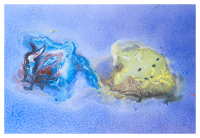Conveners
Parallel III: B10 Light Quarks
- Bernhard Ketzer (Universitaet Bonn (DE))
Jan Hartmann
(Bonn University)
08/09/2014, 14:00
Section B: Light Quarks
One of the remaining challenges within the standard model is to gain a good understanding of QCD in the low-energy, non-perturbative regime. One key towards this aim is baryon spectroscopy investigating the spectrum and the properties of baryon resonances. Unfortunately, most baryon spectroscopy data were obtained only using $\pi$ N scattering. To gain access to resonances with small $\pi$ N...
Volker Crede
(Florida State University)
08/09/2014, 14:30
Section B: Light Quarks
Nucleons are complex systems of confined quarks and gluons and exhibit the characteristic spectra of excited states. These states serve as an excellent probe of quantum chromodynamics (QCD), the fundamental theory of strong interaction. Highly-excited states are sensitive to the details of quark confinement, which is only poorly understood within QCD. This is the regime of non-perturbative QCD...
Ralf W. Gothe
(University of South Carolina)
08/09/2014, 15:00
Section B: Light Quarks
Meson-photoproduction measurements and their reaction-amplitude analyses can establish more sensitively, and in some cases in an almost model-independent way, the nucleon excitations and non-resonant reaction amplitudes. However, to investigate the strong interaction from explored – where meson-cloud degrees of freedom contribute substantially to the baryon structure – to still unexplored...
Simon Eidelman
(Novosibirsk State University)
08/09/2014, 15:30
Section B: Light Quarks
Experiments on e+e- annihilation into hadrons performed with the CMD-3
and SND detectors at the VEPP-2000 collider in Novosibirsk are described.
We report preliminary results on various two-body and multibody final states
obtained with the integrated luminosity of 60/pb per detector in the
center-of-mass energy range 320 MeV to 2000 MeV. Various applications
of these measurements, in...
